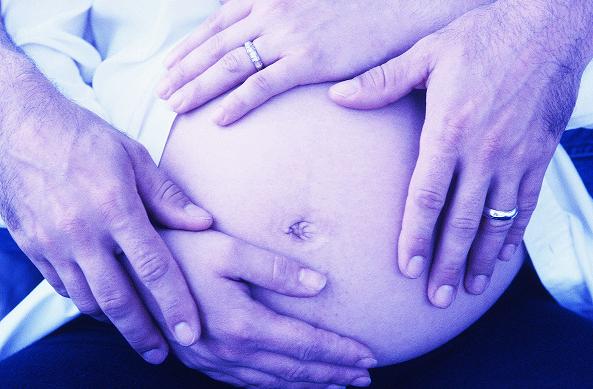 By Janelle Komorowski
By Janelle Komorowski
This article is part of A Woman's Guide to VBAC: Navigating the NIH Consensus Recommendations, a collection of resources that address the most common and pressing questions women may have about their birth choices. View all sections in the guide, including a link to the authors, on the index page.
In recent years, it has become harder to find physicians and hospitals willing to allow women to attempt a vaginal birth after cesarean (VBAC), also called a trial of labor after cesarean (TOLAC). The biggest risk attempting a VBAC is that the uterine scar may separate during labor. This is called a uterine rupture.
Although uterine rupture is not common, it can be very serious for both the mother and baby. Most hospitals in the United States now require that anesthesia, an operating room, and a surgeon be immediately available when a woman is attempting a VBAC.
Although this sounds like a good policy, it has caused some hospitals to stop allowing VBACs because they do not have adequate staff. The National Institutes of Health (NIH) VBAC Consensus Statement raises an important question: how often does uterine rupture happen, compared with other emergencies during labor?
Every labor carries a small risk of an unexpected emergency happening, so should a surgeon, anesthesia, and operating room have to be immediately available for all labors? Or should planned VBACs be treated like other labors, where the physician is nearby, but does not have to remain inside the hospital during the entire labor?
Since hospitals don't require a surgeon and anesthesiologist to be present during every labor, the NIH is asking whether the risk of VBAC has been emphasized more than other childbirth emergencies. These emergencies include placental abruption, where the placenta separates from the uterus before the baby is born; cord prolapse, where the umbilical cord is coming out in front of the baby's head; and shoulder dystocia, where the baby is stuck because its shoulders are too wide to fit through the pelvis.
To understand how often such emergencies happen during labor or birth, let's look at the following table:
| Table 1. |
| Uterine Rupture1 |
Placental Abruption2 |
Umbilical Cord Prolapse3 |
Shoulder Dystocia4 |
| 7-8 out of every 1000 VBAC attempts |
11-13 out of every 1000 labors |
14-62 out of every 1000 labors |
6-14 out of every 1000 labors |
The next table shows the risk of a baby dying as a result of one of these emergencies:
| Table 2. |
| Uterine Rupture |
Placental Abruption |
Umbilical Cord Prolapse |
Shoulder Dystocia |
| 6 out of every 100 uterine ruptures will result in a baby's death |
1.25 out of every 750 placental abruptions will result in a baby's death |
91 out of every 1000 babies with cord prolapsed will die |
1 out of every 1000 babies with shoulder dystocia will die |
The truth is, in a low-risk woman, the risk of the uterus rupturing is about the same as the risk of any serious birth emergency happening. To be considered low risk, you should have:
- One horizontal scar on your uterus (the scar on your skin may be vertical or horizontal)
- A labor that starts on its own
- No use of pitocin during labor, or prostaglandin to soften the cervix
- At least 18 months since the cesarean birth
 What are the risks of a planned repeat c-section compared to a planned VBAC? We don't have a lot of evidence to help us decide, but the risks seem to be different for the mother than the baby. About 13 out of every 100,000 women who have a cesarean birth will die from surgery complications. Only 4 out of every 100,000 women who attempt a VBAC will die as a result.
What are the risks of a planned repeat c-section compared to a planned VBAC? We don't have a lot of evidence to help us decide, but the risks seem to be different for the mother than the baby. About 13 out of every 100,000 women who have a cesarean birth will die from surgery complications. Only 4 out of every 100,000 women who attempt a VBAC will die as a result.
A repeat cesarean birth may be safer for baby. NIH figures show that 50 babies out of every 100,000 born by c-section will die. 130 out of every 100,000 babies born to mothers having a trial of labor will die. However, these numbers come from studies that included all women who had a trial of labor, even if they were high risk, had prostaglandins to soften the cervix, or pitocin during labor. In other words, these numbers do not distinguish lower-risk from higher-risk VBAC attempts.
We know that softening the cervix with prostaglandins or using pitocin during labor increases the risk of uterine rupture. If a woman does not receive prostaglandins or pitocin, the risk of her baby dying during a trial of labor is probably lower.
Worth noting is that most babies who are born after a uterine rupture do not have serious long-term problems if the baby is delivered immediately after the rupture.
The NIH is encouraging doctors and hospitals to find ways to make VBAC more available for women. One of the ways this can be done is to recognize that the absolute risks of VBAC are about the same as the risk of any other serious complication during labor and birth. Understanding these risks can help you plan a safe VBAC for your next birth.
References
1. National Institutes of Health. NIH Consensus Development Conference: Vaginal Birth After Cesarean: New Insights, draft statement. March 8!!10, 2010. Retrieved 05/12/10 from: http://consensus.nih.gov/2010/images/vbac/vbac_statement.pdf
2. Ananth CV, Wilcox AJ. Placental abruption and perinatal mortality in the United States. American Journal of Epidemiology Vol. 153, No. 4 : 332-337.
3. Murphy DJ, Mackenzie IZ. The mortality and morbidity associated with umbilical cord prolapse. British Journal of Obstetrics and Gynaecology. 1995 Oct;102(10):826-30.
4. Mackenzkie IZ, Shah M, Lean K, DuttonS, Newdick H, Tucker DE. Management of shoulder dystocia: trends in incidence and maternal and neonatal morbidity. Obstetrics and Gynecology. 2007 Nov;110(5):1059-68.
5. Vaginal Birth After Cesarean: New Insights, Structured Abstract. March 2010. Agency for Healthcare Research and Quality, Rockville, MD. http://www.ahrq.gov/clinic/tp/vbacuptp.htm
Additional Reading
Tags
Birth Preparing for VBAC A Woman's Guide to VBAC